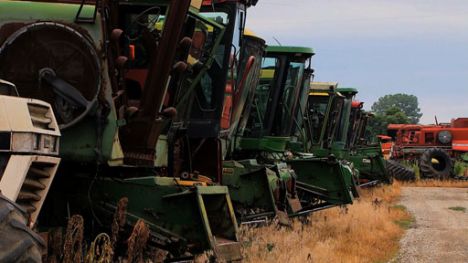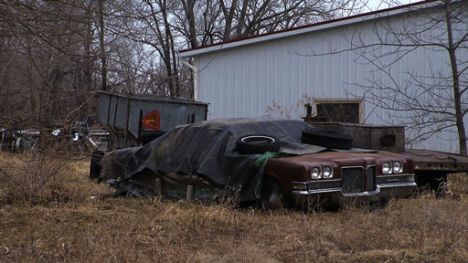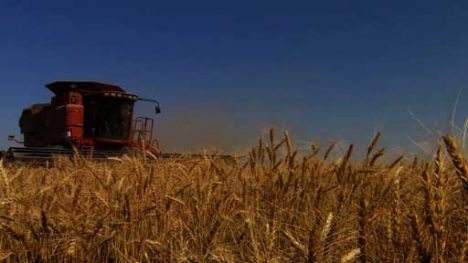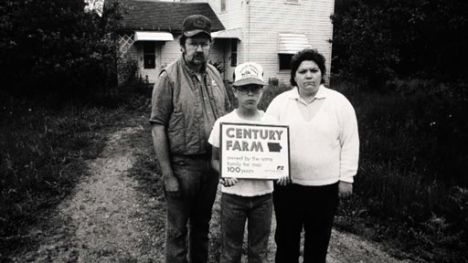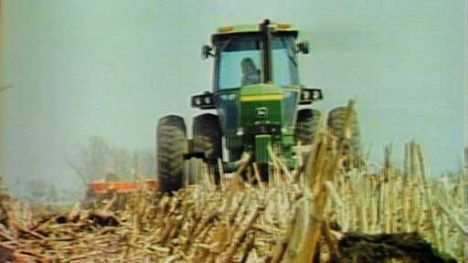
1980s Farm Crisis
During the 1980s, farmers in the United States were confronted by an economic crisis more severe than any since the Great Depression. Many of those who relied on agriculture for their livelihoods faced financial ruin. The epicenter of the downturn was in the Midwest, but the effects quickly rippled to other areas where agriculture played a prominent role in the local economy.
What caused the 1980s Farm Crisis? Who did it impact? Explore the stories about this period in time. Do any of the factors contributing to the '80s Farm Crisis exist today?
Background
During the 1980s, farmers in the United States were confronted by an economic crisis more severe than any since the Great Depression. Many of those who relied on agriculture for their livelihoods faced financial ruin. The epicenter of the downturn was in the Midwest, but the effects quickly rippled to other areas where agriculture played a prominent role in the local economy.
Causes of the Farm Crisis
In the post-World War II era, farmers witnessed revolutionary advances in agricultural technology-new machinery, seeds, pesticides, fertilizers, resulting in greater efficiency and greater productivity. During the 1950s and '60s, American agriculture's biggest problem was what to do with huge surpluses of grain. All that changed in the 1970s as the massive stockpiles were drawn down, and as a result, commodity prices rose. At the same time, demand for U.S. agricultural products exploded. The Soviet Union negotiated a multiyear contract for wheat and feed grains in 1972. And within a span of two years, wheat prices doubled, corn prices tripled. Farmers responded with increased production, and 1973 and '74 were prosperous years in rural America.
In an attempt to reduce inflation, the Federal Reserve tightened its monetary policy in 1979. As a result, interest rates rose to levels not seen since the Civil War. The prime lending rate soared from an average of 6.8 percent in 1976 to an all-time high of 21.5 percent in 1981. The impact of the Fed decision was felt throughout the U.S. economy, but its effect on farm families and rural bankers was especially severe.
Rising Farm Debt and International Events Impact Farmers
Most farmers borrow money to pay for land, equipment, seed, and other supplies. In 1950, total U.S. farm debt amounted to $12.5 billion. By 1984, the nation's farm debt was double what it had been in 1978 and 15 times the 1950 amount. At the same time, net farm income plummeted from $19 billion in 1950 to just $5.4 billion in 1984. That same year, the Federal Reserve estimated that 19 percent of America's farmers held 63 percent of the nation's total farm debt. Younger farmers -- many of whom were just starting their careers -- had little choice but to borrow large sums of money.
When President Jimmy Carter halted grain shipments to the Soviet Union in 1980 in response to Russia's invasion of Afghanistan, prices collapsed. Those who were heavily in debt were among the first to go out of business.
The Decline of The Rural Community
The '80s farm crisis accelerated a trend that had already decimated the rural economy for a half century: declining population. In 1935, the number of farms in the United States reached an all-time high of 6.8 million. By the mid-1980s, only 2.2 million farms remained.
Rural communities that once bustled with activity began to look more like ghost towns. Thousands of farm families defaulted on their loans and were forced off the land. Those who couldn't find work in nearby towns pulled up stakes in droves, and the mass exodus resulted in fewer jobs for those who stayed. Businesses and factories shut down-many never to reopen. Stores on Main Street were closed and scores of banks failed. The rapidly declining population resulted in abandoned farmhouses, diminished government services and widespread school consolidations. As the economic downturn worsened it spread to cities where manufacturers of farm implements and other agricultural supplies cut thousands of employees from their payrolls.
Lasting Impact of the Farm Crisis
By the time Congress intervened in the mid-to-late 1980s, many farmers, families, and communities felt the damage had already been done and it was a case of too little too late. Yet the farm crisis brought about profound social, political and economic reforms in the agricultural sector.
Though barely remembered by much of the urban population, painful recollections of the worst economic downturn since the Great Depression are seared into the memories of many rural Americans, as the combination of too much debt, slumping commodity prices and ill-advised government policies created a perfect storm that came to be known as the farm crisis of the 1980s.
Discovery Questions
- What were the main causes of the 1980s Farm Crisis?
- Who were the stakeholders of the 1980s Farm Crisis? Who suffered most from the crisis? Did anyone benefit?
- In what ways did international events impact the crisis?
- Are some of the factors involved in the 1980s Farm Crisis at play today?
- Do you think the agriculture industry is currently in a "boom" or "bust" period? What evidence can you find to support your opinion?
- Are there events that have taken place in your lifetime that you can compare to the 1980s Farm Crisis? What are the similarities and differences?
- Consider those businesses that survived the 1980s farm crisis and those that did not. What were the differences that led to those outcomes.
- How can you learn from past historical events to inform your business decisions in the future? What evidence would you collect to support your ideas?
- What was the government's role in the 1980s farm crisis? Did it help or hurt the situation? Back up your answer with evidence.
- What actions can an agricultural business take now to manage the impact of a future economic crisis?
Challenge: Identifying & Managing Risk
View and Print the Challenge | View and Print the Challenge Rubric
Like virtually all businesses, those in the agricultural sector are always vulnerable to good and bad years. But the Farm Crisis of the 1980s involved more than just one bad year and one good year, and had long-term implications for agriculture throughout the country. The ups and downs of any industry can be related to regular business cycles, changes in supply and demand, unexpected political events, weather disasters, and more.
Your challenge is to identify an agriculture-related business. Consider the various risks to the business and create a plan to minimize this risk. Follow the steps below as you consider how your business can survive the ups and downs.
1. Define Your Business
Think of a current or future agriculture business that you are interested in. This business can be in any sector of agriculture, such as production, transportation, agricultural processing, retail, etc.
Provide a description of your business that includes:
- A detailed description of the agriculture sector for your business
- The product and services this business would provide
- The size, scope and scale of this business
2. Identify the Risks
Once you have defined your business, identify some of the risks your business might encounter. Briefly describe each risk you have identified, detailing why it is threat to your business. Items to consider might include:
- Market demand
- Government policy
- Weather & climate
- Input costs
- Energy sources
- Diseases & pests
- Political uncertainty
- Global events
- Financing
3. Minimize Risk
What does it mean to minimize risk? What are ways that businesses minimize risks?
Create a plan for managing risk in your business. For each of the risks you identified, think of at least two ways you might manage your business to respond to each threat. Is there a solution for each problem? Your plan should explain how you would manage each of the risks you identified.
4. Evaluate Your Plan
Review another student's business description and risk management plan. Compare and contrast the business and risks with your own plan.
- Summarize your comparison of the businesses. How are they similar or different? How are your businesses interconnected? Are there risks that both business share?
- Write a short evaluation of your partner's risk management plan. Are there risks to their business that were not addressed? Can you suggest different or better ways to manage their risks?
Related Resources
- USDA Risk Management
Learn about risk management and planning, as well as access document templates. USDA, Risk Management Agency - What Recession? It's Boom Time For Nebraska Farms
This news story documents the rising grain prices during 2011, with an eye to lessons from the agriculture booms and busts of the past. NPR
Teacher Notes
Module Overview
The 1980s Farm Crisis module recounts factors, such as massive grain stockpiles and a grain contract with the Soviet Union, that lead to agricultural prosperity and economic inflation in the 1970's. This prosperity was followed by the Federal Reserve's response and resulting history-making high interest rates. It describes how farmers incurred massive debt while income declined, and how an embargo of grain to the Soviet Union caused prices to collapse. It also explores the results of the farm crisis including rural population decline, decreases in the number of farms still in business and the impact incurred on related businesses.
This module introduces students to several big ideas. Agriculture can have boom and bust cycles and there are a variety of causes for economic crises. Global issues and government intervention can play a part and these cycles have had a significant impact on rural America.
Learning Goals
This module connects with the following learning goals:
- Rank and debate the causes and events leading into the Farm Crisis.
- Infer issues and problems related to the Farm Crisis based on historical accounts.
- Illustrate the impact of recurring recessions and the growing national debt of the 1980s on the agricultural economy.
- Evaluate the impact of international events on domestic issues.
- Compare the interests, values, perspectives, and points of view of those involved in the 1980s Farm Crisis.
View and Print the Challenge | View and Print the Challenge Rubric

